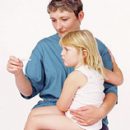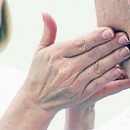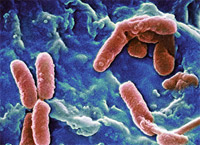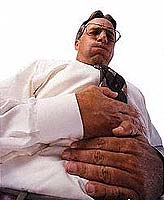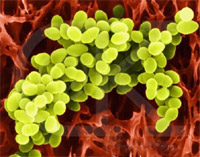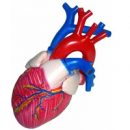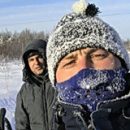Have you been brought after a meal to experience acute bouts of pain in the stomach, accompanied by vomiting, nausea or dizziness? Perhaps these were symptoms of food poisoning.
Content
Have you been brought after a meal to experience acute bouts of pain in the stomach, accompanied by vomiting, nausea or dizziness? Perhaps these were symptoms of food poisoning - diseases occurring in the use of products, poisonous in nature, or containing bacterial poisons or polluted poisonous impurities. Although most cases of food poisoning are easily curable for several days, sometimes the development of the disease can take an alarming turnover. Learn more about Salmonellic food poisoning (salmonellosis) and food poisonings caused by intestinal wand.
Food poisoning
In a wet, warm and nutrient medium, bacteria and microbes are quickly multiplied. Usually bacteria are multiplied at a temperature of 5ºC - 63ºC. Food poisoning occurs due to the use of products contaminated with bacteria, bacterial poisons, viruses, or poisonous in nature.
Food poisoning can be divided into two groups: bacterial (food toxicoinfection and nutritional intoxication) and non-bacterial (chemicals, poisonous mushrooms and herbs, poisonous fish). Antisanitary, non-compliance with the rules of hygiene during storage and packaging of food - these are the most common causes of food poisoning. Symptoms of food shipments are extremely diverse: pain in the stomach, vomiting, nausea, high temperature, and even kidney, liver and neurological syndrome.
Symptoms of food poisoning
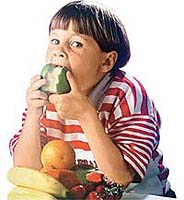 The manifestations of food poisoning depends on the type of pollution and the number of eaten contaminated or poisonous product. The first signs of food poisoning appear for 30 minutes after meals and exacerbate within the next few days. Food can cause hepatitis A viruses, Rotavirus and Norwalk (Norwalk).
The manifestations of food poisoning depends on the type of pollution and the number of eaten contaminated or poisonous product. The first signs of food poisoning appear for 30 minutes after meals and exacerbate within the next few days. Food can cause hepatitis A viruses, Rotavirus and Norwalk (Norwalk).
Symptoms of food poisoning caused by hepatitis A: sudden increase in temperature, loss of appetite, yellow eye proteins and yellowed skin. Bacterial food poisoning causes Salmonella bacteria, Campylobacter, Staphylococcus aureus (Golden Staphylococcus) and Vibrio Cholerae (Choler Vibrio).
Dieseneria caused by Schigella strain (t.N. «Traveler diarrhea») - food poisoning, whose symptoms include high temperature, diarrhea and constant calling for defecation. Botulism (Clostridium Botulinum) - another form of food poisoning. Symptoms of botulism: blurred vision with subsequent weakness and failure of the entire nervous system. The infection of this type is transmitted with honey, sausage and seafood.
Poisonous substances, for example, contained in some mushrooms, can cause nausea and vomiting, and in some cases even hallucinations and trembling paralysis. Food poisoning caused by pesticides can be obtained by eating unwashed fruits and vegetables. Typical symptoms of such poisoning: general weakness, spasms, reinforced salivation or even trembling limbs.
Liseriosis - food poisoning, which usually proceeds asymptomatic, but represents a special danger to pregnant women and the elderly. Bacteria-pathogens of lumberiosis are transmitted with crustaceans, patestones, meat semi-finished and soft cheese. Future mothers should carefully use these products, as lemaryiosis can lead to a loss of pregnancy.
Treatment of food poisoning
Little children, elderly people and pregnant women are advised to immediately consult a doctor when the first symptoms of food poisoning appears. The treatment of poisoning is also necessary if the symptoms do not disappear for a long time, especially if the disease is accompanied by vomiting, dehydrating the organism, the appearance of bleeding in feces or strong gastric colic.
Patients constantly receiving certain drugs, for example, patients with cardiovascular diseases or insulin-dependent diabetes, should immediately consult a doctor. The rapid organism of infants and young children is especially inclined to rapid dehydration, so in this case should not be slowed with treatment.
Salmonellic food poisoning
Bacteria Salmonella are in poultry meat, eggs, non-translated milk and dairy products and meat. Bacteria of this type cause gastric and intestinal infections. Salmonellosis - a very common form of food poisoning. Insufficient thermal processing of products or storage of products in unsanitary conditions can lead to salmonellosis. Salmonella bacteria die at a temperature not lower than 65.8ºC.
Symptoms of Salmonellic Food Poison: Headache, Gastric Spasms, High Temperature, Nausea, Vomiting, Diarrhea and Packs. Symptoms of salmonellosis appear within 12 - 48 hours. Salmonellosis in a light form passes within a week, but more severe cases of the disease require treatment with antibiotics. In the case of salineless food poisoning, the presence of bloody secretions in feces and symptoms of jaundice or dehydration of the body should immediately consult a doctor.
Food poisoning and pregnancy
Food poisoning during pregnancy can be avoided if carefully monitor the diet. Try to refrain from the consumption of ham, turkey and salami. PAstets, meat pastes and canned food can contain bacteria. Drink only pasteurized milk. Instead of soft cheeses (Feta, Roquefort, Camembert and Br) Choose solid cheeses.
Food poisoning caused by an intestinal stick (E coli)
E. coli intestinal wand in the courtyards of man and animals. E coli bacteria can be found in the cheese and unsolved meat, raw vegetables, as well as nonpasteurized milk. Typical symptoms of food poisoning caused by an intestinal wand (high temperature, strongest diarrhea and gastric spasms) appear within a few days. In the rare cases of this type of food poisoning, hemolytic uremic syndrome develops in patients - a disease in which the destruction of erythrocytes in the blood occurs, which leads to the refusal of the kidneys.
Secure independently
To avoid food poisoning, always wash your hands before eating. Make raw vegetables and fruits carefully. Store meat and dairy products in the refrigerator at a temperature not higher than +40C. Do not eat raw eggs. Carefully cook meat and seafood. To avoid cross-contamination of products, do not put the cooked meat on the same plate on which raw meat lay. Be sure to wash the cutting board after use. Suitable food residues immediately place in the refrigerator, t.To. Bacteria very quickly multiply at room temperature.

